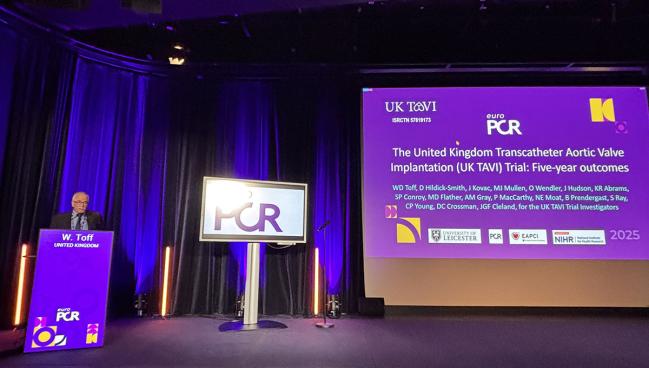Stroke Risk Higher With TAVI vs Surgery at 5 Years: UK TAVI
The higher stroke risk appears to accrue over time, and researchers say more work is needed to better understand why.

PARIS, France—New mid-term data from the United Kingdom raise some concern about a heightened risk of stroke among patients with severe aortic stenosis treated with TAVI versus those who underwent surgical aortic valve replacement.
In UK TAVI, an investigator-initiated randomized trial without industry backing, there was no difference in mortality between TAVI and SAVR at 5 years in patients initially deemed higher risk for surgery, but there was nearly a twofold increase in stroke with the less invasive procedure.
“I think it certainly needs further clarification, not the least because there may be some possibility for changing what we do with the therapeutic intervention to reduce that stroke rate,” lead investigator William Toff, MD (University of Leicester, England), told TCTMD. “This is clearly important to the people who have a stroke. It’s one of the most important outcomes from a patient perspective.”
The results, which were presented this week at EuroPCR 2025, didn’t come as a complete shock, said Toff. At 1 year, the UK TAVI investigators saw that more patients in the TAVI arm than in the surgical group had experienced a stroke, but the difference didn’t yet reach statistical significance. At 5 years, there were 59 strokes in 458 patients treated with TAVI compared with 33 strokes in 455 who underwent surgery, a statistically significant difference (HR 1.78; 95% CI 1.16-2.73).
Cardiovascular surgeon Michael Borger, MD (University of Leipzig, Germany), who wasn’t involved in the trial, called the finding an important one, noting that there were also hints of an increased stroke risk with TAVI in other studies.
“In the Evolut Low Risk study and PARTNER 3, there was no difference in stroke at 5 years between the two groups, but if you look at those stroke curves carefully, you will see there’s more periprocedural strokes with surgery, which is not surprising,” he told TCTMD. “Then the curves catch up to each other. In other words, there is an increase in the stroke rate over time in the TAVI group that’s not as pronounced in the SAVR group.”
All UK Centers Performing TAVI
UK TAVI was a pragmatic, randomized trial involving all National Health Service hospitals performing TAVI in the United Kingdom. Eligible patients were those 70 years or older with severe, symptomatic aortic stenosis and increased operative risk due to comorbidities or age.
While the aim was to enroll patients at higher operative risk, the median STS and EuroSCORE II risk scores were 2.6% and 2.0%, respectively, “making this, in reality, what would be called a low-risk trial,” said Toff. All aspects of the TAVI procedure, including choice of device, and surgery were left to the discretion of the clinical teams.
At 5 years, there was no significant difference in all-cause or cardiovascular mortality. Overall, stroke risk was significantly higher with TAVI, but investigators did not see any difference in the risks of disabling stroke, death from any stroke type, or death from disabling stroke. Quality-of-life scores favored TAVI until 12 months, but there was no difference between TAVI and surgery from 1 year onward. Conduction disturbances were significantly higher with TAVI (17.7% vs 9.2%; P < 0.001).
It certainly needs further clarification, not the least because there may be some possibility for changing what we do with the therapeutic intervention to reduce that stroke rate. William Toff
UK TAVI had deliberately broad inclusion criteria and permitted the participation of patients with bicuspid aortic valves and those requiring coronary revascularization. The investigators are planning a deep dive to see if they can identify any patient-related factors that might help explain the stroke data.
“We have looked at whether having a bicuspid valve might be a factor that accounts for the increased stroke rate in UK TAVI compared to previous trials,” said Toff, noting that the low-risk PARTNER 3 trial and Evolut Low Risk study didn’t include patients with bicuspid anatomy.
“We did find a slightly higher stroke rate in the patients who had bicuspid valves than in the patients who had a tricuspid valve, so that may be one contributing factor,” he said. Among the patients with bicuspid anatomy, the stroke rate was 16% at 5 years compared with 13% among those with tricuspid valves.
Anticoagulation might be another factor that explains some of the stroke differences.
“The anticoagulation rate throughout the trial in the TAVI group was consistently around 25% or 26%, whereas there was a higher rate of anticoagulation in the surgical group at most time points through the trial,” said Toff. “[This] might have resulted in a slightly lower stroke rate in the surgical group.”
Routine Follow-up
To TCTMD, Borger said there are some differences between UK TAVI and the industry trials. For one, patients are older in UK TAVI (81 vs 73 years in PARTNER 3/Evolut Low Risk). Another important difference is that there was no routine echocardiographic follow-up beyond 1 year unlike in the industry-funded low-risk trials.
In Evolut Low Risk and PARTNER 3, it’s possible clinicians “might occasionally see patients with some thrombus on the valve during these routine echos and those patients are treated with more aggressive anticoagulation to prevent a stroke,” he said. “We know that HALT—hypoattenuated leaflet thickening—is more common with TAVI valves than it is with surgical valves.”
Borger said one of the lessons from UK TAVI is that clinicians need to continue to watch these patients with regular echocardiographic follow-up. He noted that NOTION-2, another trial conducted in low-risk patients, albeit a younger group than in UK TAVI, reported a higher risk of stroke at 1 year in patients with bicuspid aortic valves.
Right now, Toff said further analyses are needed, including an assessment of stroke risk in patients treated with different commercial valves, but their results on the whole support the “consideration of TAVI in patients 70 years or older” at low to moderately increased risk.
“We need to better understand what factors might have caused [the higher stroke risk] before we leap to any conclusion about changing our current practice,” he told TCTMD. “I think in informing patients or discussing [the patients or] treatment options, it's important to give a clear account of the risks and benefits of procedures and to make individualized patient decisions about which treatment strategy [is best].”
Michael O’Riordan is the Managing Editor for TCTMD. He completed his undergraduate degrees at Queen’s University in Kingston, ON, and…
Read Full BioSources
Toff W. The United Kingdom Transcatheter Aortic Valve Implantation (UK TAVI) trial: Five-year outcomes. Presented at: EuroPCR 2025. May 21, 2025. Paris, France.
Disclosures
- Toff reports no relevant conflicts of interest.
- Borger reports honoraria and/or consulting paid to his hospital from Edwards Lifesciences, Medtronic, Abbott, and Artivion.





Comments